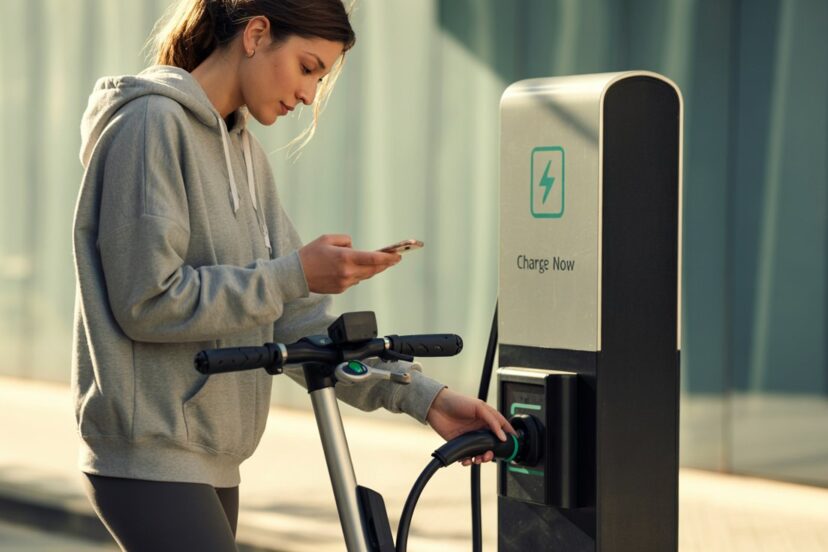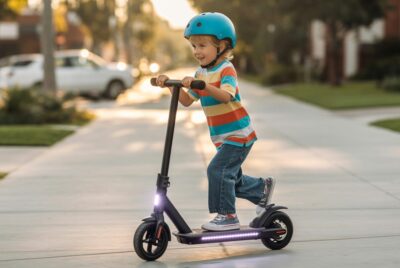E-Scooter Fast Charging: Revolutionary Solutions
*We may earn a commission for purchases made using our links. Please see our disclosure to learn more.
The electric scooter revolution has transformed urban mobility, but one critical challenge remains at the forefront of every rider’s mind: charging time. As cities embrace sustainable transportation and commuters seek efficient alternatives to traditional vehicles, the demand for rapid, reliable charging solutions has never been more urgent. The evolution from basic overnight charging to lightning-fast power delivery systems represents a technological leap that’s reshaping how we think about electric mobility.
“The future of urban mobility depends not just on electric vehicles, but on our ability to charge them as quickly as we can fuel conventional vehicles.”
— International Energy Agency Report on Electric Vehicle Infrastructure, 2024
Key Takeaways
- Fast charging technology can reduce e-scooter charging times from 4-8 hours to 30-90 minutes
- Smart charging systems optimize battery health while delivering rapid power
- Portable charging solutions offer flexibility for users without dedicated parking
- Infrastructure development is crucial for widespread fast charging adoption
- Battery management systems are essential for safe, efficient fast charging
The Current Charging Landscape
Traditional e-scooter charging has long been characterized by lengthy wait times and inconvenient processes. Most standard e-scooters require 4-8 hours for a complete charge, forcing riders to plan their journeys around battery limitations. This constraint has created a significant barrier to adoption, particularly for commuters who need reliable, quick turnaround times.
The frustration of waiting hours for a full charge has driven innovation in the charging technology sector. Manufacturers and technology developers have responded with increasingly sophisticated solutions that address both speed and safety concerns.
Revolutionary Fast Charging Technologies
Lithium-Ion Battery Optimization
Modern fast charging solutions leverage advanced lithium-ion battery chemistry specifically designed for rapid energy absorption. These batteries incorporate silicon nanowire anodes and high-voltage cathode materials that can safely handle higher charging currents without degradation.
The key breakthrough lies in battery management systems that monitor cell temperature, voltage, and current in real-time. These systems dynamically adjust charging rates to maximize speed while preventing overheating and extending battery lifespan.
Smart Charging Algorithms
Intelligent charging algorithms represent a significant advancement in fast charging technology. These systems analyze battery condition, ambient temperature, and charging history to optimize the charging curve. The algorithm starts with high-current charging when the battery is nearly empty, then gradually reduces current as the battery approaches full capacity.
This approach prevents the “charging cliff” effect where charging speed dramatically slows near 100% capacity, ensuring users get maximum range quickly even if they can’t wait for a complete charge.
High-Power Charging Stations
Commercial fast charging stations now deliver 500-1000 watts of power compared to standard home chargers’ 100-200 watts. These stations incorporate advanced cooling systems, surge protection, and smart grid integration to provide safe, rapid charging.
The stations feature multiple charging ports with different connector types, accommodating various e-scooter models while providing real-time charging status updates through mobile applications.
Portable Fast Charging Solutions
Compact Power Banks
High-capacity portable chargers designed specifically for e-scooters have revolutionized charging flexibility. These units typically weigh 2-4 pounds and can deliver 200-400 watts of power, enabling 50-80% charges in 45-90 minutes.
Advanced portable chargers include built-in cooling systems, multiple output options, and smartphone apps for monitoring charging progress remotely. Some models feature solar panel integration for emergency charging in outdoor environments.
Modular Battery Systems
Removable battery packs represent another innovative approach to fast charging. Users can remove depleted batteries and insert fully charged ones in seconds, effectively providing instant “charging.” This system requires investment in multiple battery packs but eliminates downtime entirely.
These modular systems often include smart charging docks that can simultaneously charge multiple batteries while providing battery health monitoring and maintenance alerts.
Overcoming Common Charging Challenges
Heat Management
Fast charging generates significant heat, which can damage batteries and create safety hazards. Modern solutions incorporate active cooling systems using fans, heat sinks, and in some cases, liquid cooling to maintain optimal operating temperatures.
Temperature monitoring systems automatically reduce charging speed if batteries become too hot, balancing speed with safety and longevity.
Power Grid Integration
High-power fast charging stations require substantial electrical infrastructure. Smart charging networks now incorporate load balancing, peak demand management, and renewable energy integration to minimize grid impact while maximizing charging speed.
These systems can store energy during off-peak hours and deliver it rapidly during high-demand periods, reducing costs and environmental impact.
Battery Lifespan Concerns
Frequent fast charging historically reduced battery lifespan, but modern battery chemistry and management systems have largely addressed this concern. Advanced lithium-ion batteries designed for fast charging can maintain 80% capacity after 1000+ fast charge cycles.
Intelligent charging systems monitor battery health continuously, adjusting charging parameters to optimize longevity while maintaining rapid charging capabilities.
Infrastructure Development and Urban Integration
Public Charging Networks
Cities worldwide are investing in comprehensive fast charging infrastructure. These networks include strategically placed charging stations at transit hubs, commercial centers, and residential areas to ensure convenient access for all users.
Integration with existing urban infrastructure, such as streetlights and parking meters, maximizes coverage while minimizing visual impact and installation costs.
Workplace Integration
Forward-thinking employers are installing fast charging stations in workplace parking areas, enabling employees to quickly charge during lunch breaks or meetings. This approach supports sustainable commuting while reducing charging anxiety.
Residential Solutions
Multi-unit residential buildings are incorporating fast charging infrastructure in parking areas and storage facilities. These systems often include payment processing, usage tracking, and load management to efficiently serve multiple residents.
Environmental Impact and Sustainability
Fast charging networks increasingly integrate renewable energy sources, including solar panels and wind power. Energy storage systems allow charging stations to operate independently during peak renewable generation periods, reducing reliance on fossil fuel-based grid power.
Smart charging algorithms can prioritize renewable energy usage, automatically adjusting charging schedules to coincide with peak solar or wind generation periods.
Economic Considerations
Cost-Benefit Analysis
While fast charging systems require higher initial investment, they provide significant long-term benefits including reduced downtime, increased vehicle utilization, and improved user satisfaction. Commercial operators often see return on investment within 12-18 months.
Pricing Models
Innovative pricing structures for fast charging include per-minute rates, subscription models, and dynamic pricing based on demand and energy costs. These models make fast charging accessible while encouraging efficient usage.
Future Innovations and Trends
Wireless Charging Integration
Emerging wireless charging technology promises to eliminate physical connections entirely. Inductive charging pads embedded in parking areas or roadways could enable automatic charging without user intervention.
Ultra-Fast Charging Development
Next-generation charging technology aims to achieve 80% charges in 10-15 minutes through advanced battery chemistry, cooling systems, and power delivery methods.
Smart City Integration
Future fast charging networks will integrate with smart city infrastructure, providing real-time availability updates, route optimization, and predictive maintenance capabilities.
Practical Implementation Strategies
Choosing the Right Solution
Selecting appropriate fast charging solutions depends on usage patterns, budget constraints, and infrastructure availability. Commuters benefit from workplace charging, while recreational users might prefer portable solutions.
Installation Considerations
Proper installation requires electrical system assessment, permitting, and professional installation to ensure safety and optimal performance. Many solutions qualify for government incentives and rebates.
Maintenance and Optimization
Regular maintenance ensures optimal charging performance and extends equipment lifespan. Smart systems provide predictive maintenance alerts and remote monitoring capabilities.
Safety and Standards Compliance
Fast charging systems must comply with rigorous safety standards including UL certification, IP weather ratings, and electrical code requirements. Built-in safety features include ground fault protection, surge suppression, and emergency shutdown capabilities.
Regular safety inspections and user education ensure safe operation and prevent accidents or equipment damage.
Conclusion
Fast charging solutions for e-scooters represent a transformative technology that addresses one of the most significant barriers to electric mobility adoption. From advanced battery chemistry and smart algorithms to comprehensive charging infrastructure, these innovations are reshaping urban transportation.
The convergence of technological advancement, infrastructure development, and environmental consciousness creates an unprecedented opportunity for sustainable urban mobility. As charging times decrease and convenience increases, e-scooters become increasingly viable alternatives to traditional transportation methods.
Success in implementing fast charging solutions requires careful consideration of user needs, infrastructure capabilities, and long-term sustainability goals. The investment in fast charging technology today will determine the accessibility and adoption of electric mobility tomorrow, ultimately contributing to cleaner, more efficient urban environments.
The future of e-scooter transportation lies not just in the vehicles themselves, but in the charging ecosystem that supports them. As technology continues advancing and infrastructure expands, fast charging will become the standard rather than the exception, enabling truly convenient electric mobility for everyone.
Frequently Asked Questions
1. How much faster is fast charging compared to standard charging?
Fast charging can reduce charging times from 4-8 hours to 30-90 minutes, depending on the battery capacity and charging system. Some ultra-fast systems can achieve 80% charge in as little as 15-20 minutes, representing a 10-15x improvement over standard charging methods.
2. Does fast charging damage the battery or reduce its lifespan?
Modern fast charging systems are designed to protect battery health through intelligent management systems. While early fast charging technology could reduce battery life, current systems with proper thermal management and optimized charging curves can maintain battery health comparable to standard charging methods.
3. What’s the cost difference between fast charging and regular charging?
Fast charging typically costs 20-50% more per session due to higher infrastructure costs and peak demand charges. However, the time savings often justify the additional cost for frequent users. Many charging networks offer subscription plans that reduce per-session costs.
4. Can I install a fast charging station at home?
Yes, residential fast charging stations are available, though they may require electrical system upgrades to handle higher power demands. Installation costs range from $500-2000 depending on electrical requirements and local permit fees. Many installations qualify for rebates and tax incentives.
5. Are fast charging stations compatible with all e-scooter models?
Most fast charging stations offer multiple connector types and adjustable power outputs to accommodate different e-scooter models. However, older scooters may not support fast charging speeds due to battery limitations. Check your scooter’s specifications and charging capabilities before using high-power charging stations.




